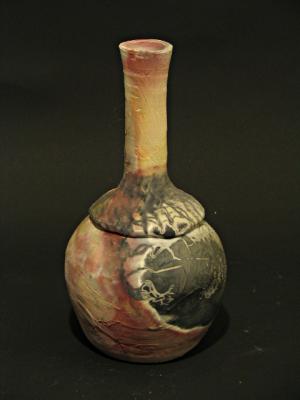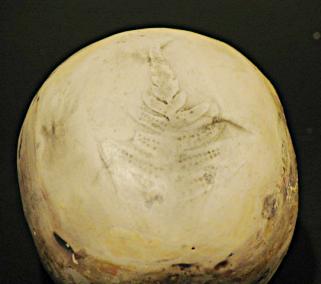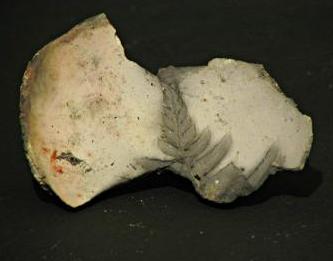Besides toying with Chore Boy copper netting and steel wool, I also performed some other experiments in the Vashon Island pit firing last month. Here is a brief summary of these other experiments:

One experiment involves a piece which was completely unburnished, with no terra sig applied, and with a strongly textured surface from the thickly painted engobe. As you can see, the result (figure 1 above) has a very different quality from those other highly burnished pieces. Nevertheless, it is quite charming in its own way — there’s something simple and bold, and almost more honest about it… (perhaps because it’s less self-consciously trying to be beautiful?)
Packing materials: the usual cast of Chore-Boy, steel wool strands, salted raffia and salted burlap. The visible black and white net-like pattern apparently came from the Chore-Boy netting.

Another experiment involves transferring an image of vegetation onto a piece’s surface, which, as I mentioned before, was a technique first described by Dick Lehman in a Ceramic Monthly article. My last attempt at this yielded something that could conceivably be a plant’s image, but I couldn’t prove it. This time, however, there’s no doubt it’s the image of the fern (figure 2 above) I had placed there under a clay mask. Of course, it’s a far cry from the elegant shapes and patterns in Dick’s exquisite work — but my crude imitation worked well enough as a proof of concept, and that’s good enough for our purpose here.
Notice the subtle yellow-orange blushes near the edges of where the clay mask was — the clay mask apparently masked out most but not all the fuming from the packing materials (salted raffia, copper carbonate, etc.) — so clay masks could conceivably be used to create areas of soft, subtle colors. I think this is how some subtle color blushes got onto an early favorite piece from my first firing.

Interestingly, the clay mask itself picked up far more colors from the fuming materials and carbon from the fern (figure 3 above) than the piece itself — which goes to show how much more receptive to smoking and fuming unfired clay is compared to bisqueware.
Finally, there was one last experiment in the mix: I performed yet another banana test — i.e. using banana peels as the main fuming material. Well, this time I didn’t get any of the deep red that I used to associate banana peels with. Actually I hardly got any colors on the piece at all. Am I ready to write banana peels off yet? Not quite, but I certainly am becoming more skeptical now…